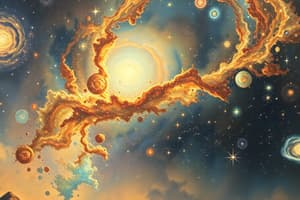Podcast
Questions and Answers
What type of data do we use to understand the universe?
What type of data do we use to understand the universe?
Remotely sensed data using powerful telescopes and actual space explorations.
What is Voyager 1?
What is Voyager 1?
A spacecraft launched by NASA in 1977 that crossed into interstellar space in 2012.
Who were the discoverers of the cosmic microwave background (CMB)?
Who were the discoverers of the cosmic microwave background (CMB)?
Arno Allan Penzias and Robert Woodrow Wilson.
What does the Big Bang Theory explain?
What does the Big Bang Theory explain?
The steady-state theory is the most accepted cosmological model today.
The steady-state theory is the most accepted cosmological model today.
What characterizes the Steady State Theory?
What characterizes the Steady State Theory?
What phenomenon is described by redshift and blueshift?
What phenomenon is described by redshift and blueshift?
What is the Higgs boson?
What is the Higgs boson?
The __________ represents the heat left over from the Big Bang.
The __________ represents the heat left over from the Big Bang.
What does the Inflation Model of the Universe describe?
What does the Inflation Model of the Universe describe?
What does the term 'multiverse' refer to?
What does the term 'multiverse' refer to?
Flashcards are hidden until you start studying
Study Notes
The Origin and Evolution of Our Universe
- Knowledge about the universe relies on powerful telescopes, such as Hubble, and data from NASA and ESA missions.
- Voyager 1, launched in 1977, is the farthest spacecraft from Earth, crossing into interstellar space in August 2012 and continues to gather data.
- Voyager missions help scientists understand energy and radiation in space; Voyager 1 carries the Golden Record with messages and music from humanity.
- The universe began approximately 13.8 billion years ago from an explosive event, leading to the creation of subatomic particles and basic elements like Hydrogen and Helium.
- The cosmic microwave background (CMB), discovered in 1965, is an afterglow radiation from the initial explosion, representing the universe's early state.
Theories on the Origin of the Universe
- Big Bang Theory: Proposes the universe originated from a singularity, expanding over time. Georges Lemaitre first proposed this theory.
- Steady State Theory: Suggests continuous matter creation keeps the universe's density constant over time; inconsistent with CMB observations.
- Cyclic Model: Views the Big Bang as a transition to a previous phase, proposing a cyclical evolution of the universe with key events occurring during slow contraction.
- Inflation Model: Suggests a rapid expansion occurred shortly after the Big Bang, explaining the universe's flatness and uniformity before the CMB emerged.
- Multiverse Model: Hypothesizes multiple observable universes, each containing its own communities of observers, expanding on the notion of diverse cosmic realities.
Evidence Supporting the Big Bang Theory
- CMB represents the heat from the Big Bang and is detected as radiation in the microwave spectrum, measuring 2.725 degrees above absolute zero.
- Spectral shifts (redshift and blueshift) provide evidence of the universe's expansion; distant stars and galaxies appear to shift towards longer or shorter wavelengths based on their movement.
- The Higgs boson, identified as the particle that provides mass to elementary particles, supports foundational theories regarding cosmic events and the nature of mass.
Studying That Suits You
Use AI to generate personalized quizzes and flashcards to suit your learning preferences.



